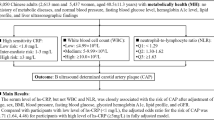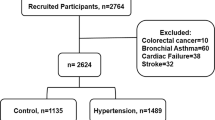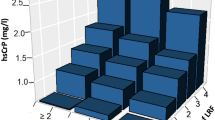Abstract
OBJECTIVE: To elucidate the underlying mechanisms between C-reactive protein (CRP) and cardiovascular disease, we exa-mined the association of circulating CRP in healthy reference range (≤1.0 mg/dl) measured by high-sensitive CRP assay with the metabolic syndrome (MS).
DESIGN: Cross-sectional study of circulating CRP in adult men.
SUBJECTS: A total of 3692 Japanese men aged 34–69 y.
MEASUREMENTS: Serum CRP, total cholesterol, triglycerides, LDL-cholesterol, fasting glucose, fasting insulin, uric acid, systolic blood pressure, diastolic blood pressure, and body mass index (BMI).
RESULTS: There was a statistically significant positive correlation between CRP and BMI (r=0.25), total cholesterol (r=0.096), triglycerides (r=0.22), LDL-cholesterol (r=0.12), fasting glucose (r=0.088), fasting insulin (r=0.17), uric acid (r=0.13), systolic blood pressure (r=0.12), and diastolic blood pressure (r=0.11), and a significant negative correlation of CRP with HDL-cholesterol (r=0.24). After adjusting for age, smoking, and all other components of MS, obesity, hypertriglyceridemia, hyper-LDL-cholesterolemia, diabetes, hyperinsulinemia, and hyperuricemia were significantly associated with both mildly (≥0.06 mg/dl) and moderately (≥0.11 mg/dl) elevated CRP. Compared with men who had no such components of the MS, those who had one, two, three, four, and five or more components were, respectively, 1.48, 1.84, 1.92, 3.42, and 4.17 times more likely to have mildly elevated CRP levels (trend P<0.001). As for moderately elevated CRP, the same association was observed.
CONCLUSIONS: These results indicate that a variety of components of the MS are associated with elevated CRP levels in a systemic low-grade inflammatory state.
This is a preview of subscription content, access via your institution
Access options
Subscribe to this journal
Receive 12 print issues and online access
$259.00 per year
only $21.58 per issue
Buy this article
- Purchase on Springer Link
- Instant access to full article PDF
Prices may be subject to local taxes which are calculated during checkout
Similar content being viewed by others
References
Pepys MB . C-reactive protein fifty years on. Lancet 1981; 1: 653–657.
Gauldie J, Richards C, Northemann W, Fey G, Baumann H . IFN beta 2/BSF2/IL-6 is the monocyte-derived HSF that regulates receptor-specific acute phase gene regulation in hepatocytes. Ann NY Acad Sci 1989; 557: 46–58.
Heinrich PC, Castell JV, Andus T . Interleukin-6 and the acute phase response. Biochem J 1990; 265: 621–636.
Baumann H, Gauldie J . The acute phase response. Immunol Today 1994; 15: 74–80.
Chambers JC, Eda S, Bassett P, Karim Y, Thompson SG, Gallimore JR, Pepys MB, Kooner JS . C-reactive protein, insulin resistance, central obesity, and coronary heart disease risk in Indian Asians from the United Kingdom compared with European whites. Circulation 2001; 104: 145–150.
Danesh J, Whincup P, Walker M, Lennon L, Thomson A, Appleby P, Gallimore JR, Pepys MB . Low grade inflammation and coronary heart disease: prospective study and updated meta-analyses. BMJ 2000; 321: 199–204.
Rifai N, Ridker PM . High-sensitivity C-reactive protein: a novel and promising marker of coronary heart disease. Clin Chem 2001; 47: 403–411.
Strandberg TE, Tilvis RS . C-reactive protein, cardiovascular risk factors, and mortality in a prospective study in the elderly. Arterioscler Thromb Vasc Biol 2000; 20: 1057–1060.
Danesh J, Collins R, Appleby P, Peto R . Association of fibrinogen, C-reactive protein, albumin, or leukocyte count with coronary heart disease: meta-analyses of prospective studies. JAMA 1998; 279: 1477–1482.
Kuller LH, Tracy RP, Shaten J, Meilahn EN . Relation of C-reactive protein and coronary heart disease in the MRFIT nested case-control study, multiple risk factor intervention trial. Am J Epidemiol 1996; 144: 537–547.
Ridker PM, Cushman M, Stampfer MJ, Tracy RP, Hennekens CH . Inflammation, aspirin, and the risk of cardiovascular disease in apparently healthy men. N Engl J Med 1997; 336: 973–979.
Tracy RP, Lemaitre RN, Psaty BM, Ives DG, Evans RW, Cushman M, Meilahn EN, Kuller LH . Relationship of C-reactive protein to risk of cardiovascular disease in the elderly. Results from the Cardiovascular Health Study and the Rural Health Promotion Project. Arterioscler Thromb Vasc Biol 1997; 17: 1121–1127.
Koenig W, Sund M, Frohlich M, Fischer HG, Lowel H, Doring A, Hutchinson WL, Pepys MB . C-Reactive protein, a sensitive marker of inflammation, predicts future risk of coronary heart disease in initially healthy middle-aged men: results from the MONICA (monitoring trends and determinants in cardiovascular disease) Augsburg Cohort Study, 1984 to 1992. Circulation 1999; 99: 237–242.
Lagrand WK, Visser CA, Hermens WT, Niessen HW, Verheugt FW, Wolbink GJ, Hack CE . C-reactive protein as a cardiovascular risk factor: more than an epiphenomenon. Circulation 1999; 100: 96–102.
Ferrannini E, Haffner SM, Mitchell BD, Stern MP . Hyperinsulinaemia: the key feature of a cardiovascular and metabolic syndrome. Diabetologia 1991; 34: 416–422.
Gray RS, Fabsitz RR, Cowan LD, Lee ET, Howard BV, Savage PJ . Risk factor clustering in the insulin resistance syndrome. The strong heart study. Am J Epidemiol 1998; 148: 869–878.
Howard BV, Lee ET, Cowan LD, Fabsitz RR, Howard WJ, Oopik AJ, Robbins DC, Savage PJ, Yeh JL, Welty TK . Coronary heart disease prevalence and its relation to risk factors in American Indians. The strong heart study. Am J Epidemiol 1995; 142: 254–268.
SPSS Incorporation. SPSS Base 10.0J user's guide. SPSS INC: Chicago, IL, 1999.
Festa A, D'Agostino Jr R, Williams K, Karter AJ, Mayer-Davis EJ, Tracy RP, Haffner SM . The relation of body fat mass and distribution to markers of chronic inflammation. Int J Obes Relat Metab Disord 2001; 25: 1407–1415.
Yamada S, Gotoh T, Nakashima Y, Kayaba K, Ishikawa S, Nago N, Nakamura Y, Itoh Y, Kajii E . Distribution of serum C-reactive protein and its association with atherosclerotic risk factors in a Japanese population: Jichi Medical School Cohort Study. Am J Epidemiol 2001; 153: 1183–1190.
Pannacciulli N, Cantatore FP, Minenna A, Bellacicco M, Giorgino R, De Pergola G . C-reactive protein is independently associated with total body fat, central fat, and insulin resistance in adult women. Int J Obes Relat Metab Disord 2001; 25: 1416–1420.
Mendall MA, Patel P, Ballam L, Strachan D, Northfield TC . C reactive protein and its relation to cardiovascular risk factors: a population based cross sectional study. BMJ 1996; 312: 1061–1065.
Frohlich M, Imhof A, Berg G, Hutchinson WL, Pepys MB, Boeing H, Muche R, Brenner H, Koenig W . Association between C-reactive protein and features of the metabolic syndrome: a population-based study. Diabetes Care 2000; 23: 1835–1839.
Hotamisligil GS, Shargill NS, Spiegelman BM . Adipose expression of tumor necrosis factor-alpha: direct role in obesity-linked insulin resistance. Science 1993; 259: 87–91.
Mohamed-Ali V, Goodrick S, Rawesh A, Katz DR, Miles JM, Yudkin JS, Klein S, Coppack SW . Subcutaneous adipose tissue releases interleukin-6, but not tumor necrosis factor-alpha, in vivo. J Clin Endocrinol Metab 1997; 82: 4196–4200.
Fernandez-Real JM, Vayreda M, Richart C, Gutierrez C, Broch M, Vendrell J, Ricart W . Circulating interleukin 6 levels, blood pressure, and insulin sensitivity in apparently healthy men and women. J Clin Endocrinol Metab 2001; 86: 1154–1159.
Hotamisligil GS, Arner P, Caro JF, Atkinson RL, Spiegelman BM . Increased adipose tissue expression of tumor necrosis factor-alpha in human obesity and insulin resistance. J Clin Invest 1995; 95: 2409–2415.
Kern PA, Saghizadeh M, Ong JM, Bosch RJ, Deem R, Simsolo RB . The expression of tumor necrosis factor in human adipose tissue, Regulation by obesity, weight loss, and relationship to lipoprotein lipase. J Clin Invest 1995; 95: 2111–2119.
Baumann H, Gauldie J . Regulation of hepatic acute phase plasma protein genes by hepatocyte stimulating factors and other mediators of inflammation. Mol Biol Med 1990; 7: 147–159.
Vgontzas AN, Papanicolaou DA, Bixler EO, Kales A, Tyson K, Chrousos GP . Elevation of plasma cytokines in disorders of excessive daytime sleepiness: role of sleep disturbance and obesity. J Clin Endocrinol Metab 1997; 82: 1313–1316.
Heinrich J, Schulte H, Schonfeld R, Kohler E, Assmann G . Association of variables of coagulation, fibrinolysis and acute-phase with atherosclerosis in coronary and peripheral arteries and those arteries supplying the brain. Thromb Haemost 1995; 73: 374–379.
Ridker PM, Buring JE, Shih J, Matias M, Hennekens CH . Plasma concentration of C-reactive protein and risk of developing peripheral vascular disease. Circulation 1998; 97: 425–428.
Folsom AR, Pankow JS, Tracy RP, Arnett DK, Peacock JM, Hong Y, Djousse L, Eckfeldt JH . Association of C-reactive protein with markers of prevalent atherosclerotic disease. Am J Cardiol 2001; 88: 112–117.
Hashimoto H, Kitagawa K, Hougaku H, Shimizu Y, Sakaguchi M, Nagai Y, Iyama S, Yamanishi H, Matsumoto M, Hori M . C-reactive protein is an independent predictor of the rate of increase in early carotid atherosclerosis. Circulation 2001; 104: 63–67.
Hansson GK . Immune and inflammatory mechanisms in the development of atherosclerosis. Br Heart J 1993; 69: 38–41.
Juhan-Vague I, Thompson SG, Jespersen J . Involvement of the hemostatic system in the insulin resistance syndrome, A study of 1500 patients with angina pectoris, The ECAT Angina Pectoris Study Group. Arterioscler Thromb 1993; 13: 1865–1873.
Fourcade O, Simon MF, Viode C, Rugani N, Leballe F, Ragab A, Fournie B, Sarda L, Chap H . Secretory phospholipase A2 generates the novel lipid mediator lysophosphatidic acid in membrane microvesicles shed from activated cells. Cell 1995; 80: 919–927.
Hack CE, Wolbink GJ, Schalkwijk C, Speijer H, Hermens WT, van den Bosch H . A role for secretory phospholipase A2 and C-reactive protein in the removal of injured cells. Immunol Today 1997; 18: 111–115.
Wolbink GJ, Brouwer MC, Buysmann S, ten Berge IJ, Hack CE . CRP-mediated activation of complement in vivo: assessment by measuring circulating complement-C-reactive protein complexes. J Immunol 1996; 157: 473–479.
Acknowledgements
We are grateful to Dr Noboru Okamoto (Aichi San-no-maru Hospital), Dr Tsutomu Yoshida (Department of Public Health, Fujita Health University School of Medicine), Dr Takashi Kawamura (Kyoto University Center for Student Health), and Dr Junji Toyama (Aichi Prefectural Owari Hospital) for their cooperation in conducting the survey and collecting information for this study.
This work is supported in part by a grant to Hideaki Toyoshima (09470112), Koji Tamakoshi (12670352), and Hiroshi Yatsuya (13770192) from the Ministry of Education, Culture, Sports, and Science and Technology.
Author information
Authors and Affiliations
Corresponding author
Rights and permissions
About this article
Cite this article
Tamakoshi, K., Yatsuya, H., Kondo, T. et al. The metabolic syndrome is associated with elevated circulating C-reactive protein in healthy reference range, a systemic low-grade inflammatory state. Int J Obes 27, 443–449 (2003). https://doi.org/10.1038/sj.ijo.0802260
Received:
Revised:
Accepted:
Published:
Issue Date:
DOI: https://doi.org/10.1038/sj.ijo.0802260
Keywords
This article is cited by
-
Tumor necrosis factor-alpha and high sensitivity C-reactive protein in young patients with diabetes mellitus
International Journal of Diabetes in Developing Countries (2023)
-
Comparison of serum cytokines between gestational diabetes mellitus and normal pregnancy women: a pilot study
International Journal of Diabetes in Developing Countries (2022)
-
Curcuma longa extract improves serum inflammatory markers and mental health in healthy participants who are overweight: a randomized, double-blind, placebo-controlled trial
Nutrition Journal (2021)
-
Assessment of plasminogen activator inhibitor-1 in obese Egyptian children
Egyptian Pediatric Association Gazette (2020)
-
A high-fat diet stimulates fibroblast growth factor 23 formation in mice through TNFα upregulation
Nutrition & Diabetes (2018)



